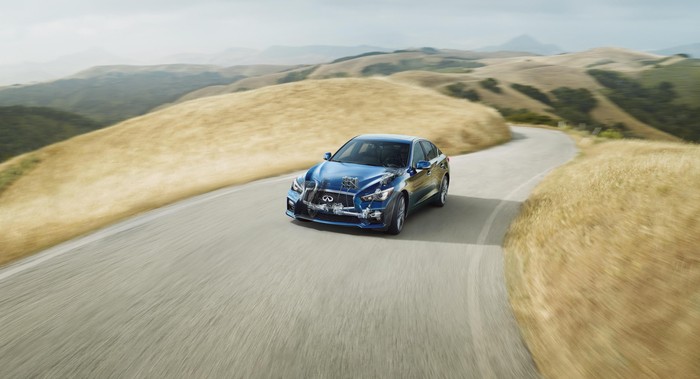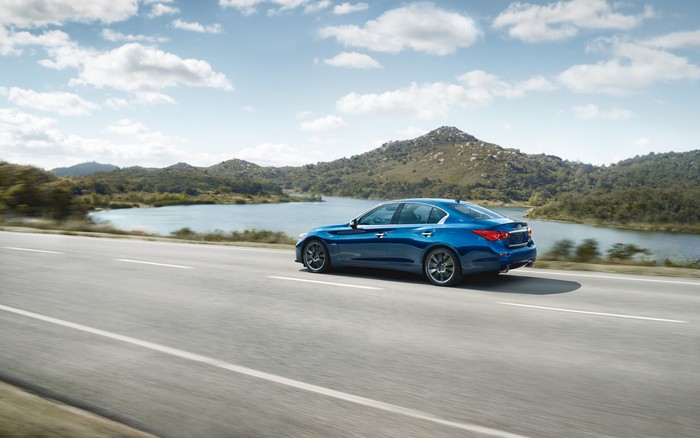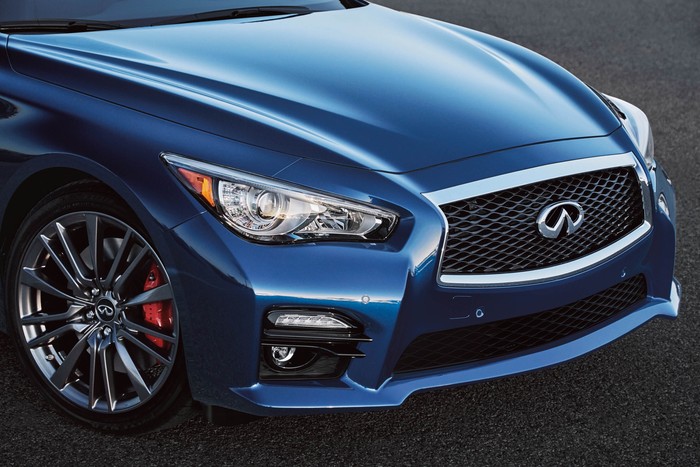

2019 Infiniti Q50
The Q50 is Infiniti's rival for compact luxury sedans like the BMW 3 Series and Audi A4. It boasts sharp styling, whiz-bang technology, and an engaging driving experience.
Recent changes
For the latest model year, Infiniti eliminated the hybrid model from the Q50 line-up.
Overview
Viewed head-on, the Q50's front end features a tapered, very vertical front fascia with a gigantic Infiniti badge centered on its grille. From the side, the car appears more curvaceous than before, and its distinctive C-pillar kink points to the future of Infiniti's styling language. As per Infiniti tradition, the rear end is distinguished by a tall trunk lid with an integrated spoiler and twin exhaust pipes.
If the Q50 strikes you as particularly streamlined, don't chalk it up to a stylistic trick - Infiniti says the sedan boasts an impressively slippery 0.26 coefficient of drag and features no front or rear lift.
Inside, the Q50 follows the dual-cowl styling of its predecessor, although the switchgear on the center stack is much more high-tech. In place of most of the conventional buttons found in the G37, there's a new Infiniti InTouch infotainment system that takes the form of two touch screens that display system, navigation (when equipped) and connectivity info.
InTouch comes pre-loaded with a selection of vehicle-centric apps, and owners have the option of downloading, updating and synching personal apps through their smartphones. The system also integrates conventional controls for HVAC functions.
The interior makes extensive use of genuine aluminum and it will offer maple wood as an extra. Leatherette seating surfaces is standard, while leather, heated trim and sports seats are on the options list.
Though the Q50's 112.2-inch wheelbase is identical to that of the G37, overall length has grown by five inches (to 188.3 inches). Rear seat legroom is improved, and the trunk now measures a voluminous 18 cubic inches.
On the tech front, the Q50 offers numerous cameras, including a 360-degree-style around view screen, intelligent cruise control, forward collision warning, forward emergency braking and back-up collision intervention, among other goodies.
Technical specifications
The Q50 sedan is available with four different engine options, three of which feature turbocharging.
Entry-level models come with a Mercedes-Benz-sourced, 2.0-liter four-cylinder engine turbocharged to make 208 horsepower at 5,500 rpm and 258 pound-feet of torque from 1,500 rpm. Rear-wheel drive comes standard and all-wheel drive is offered at an extra cost.
Buyers who want more power have several V6 options to choose from. In its standard form, the 3.0-liter six makes 300 horsepower and 295 pound-feet of torque. In the Red Sport models, output climbs to 400 horsepower and 350 pound-feet of torque.
All Q50s regardless of engine type come with a seven-speed automatic transmission.
Buyers can opt for a steer-by-wire Direct Adaptive Steering that electrically transmits driver inputs to the wheels. A backup mechanical system is included in case of any glitches. The system is able to react more quickly than is possible with a normal mechanical system, and it also allows the driver to tailor steering effort and speed to suit his or her tastes. However it's worth nothing that the setup has drawn criticism for artificial-seeming feedback and an anodyne overall feel.
Uniquely, Direct Adaptive Steering uses a camera located above the rear-view mirror to read the road ahead and make small steering adjustments to compensate for road imperfections, weather conditions or unintended lane drift - marking another step towards the advent of autonomous vehicle technology.
Standard and optional features
The Q50 line-up includes four models named 2.0t Pure, 3.0t Luxe, 3.0t Sport, and Red Sport 400, respectively. Each one is offered with standard rear-wheel drive or optional all-wheel drive.
The base Q50 comes standard with dual-zone automatic climate control, LED headlights, LED taillights, a proximity key, rain-sensing wipers, push-button start, power-adjustable front seats, leatherette seating upholstery, a leather-wrapped steering wheel, a six-speaker AM/FM/CD stereo system with two USB inputs and satellite radio, eight-inch upper and seven-inch lower touchscreen displays, Bluetooth connectivity, cruise control and 17-inch alloy wheels.
Infiniti offers option packages on some trim levels. For example, the 3.0t Luxe trim is available with a package named Essential that adds a heated steering wheel, heated front seats, and a remote engine starter.
Occupant safety
All Q50 models come standard with dual front, front-side and full-length side curtain airbags in addition to traction and stability control systems.
The Q50 can also be optioned with advanced safety technologies that will warn the driver of impending front or rear collisions and, if necessary, apply the brakes to prevent or mitigate the severity of the crash. A separate system alerts the driver if the Q50 begins to wander into an adjacent lane and can actually apply slight steering inputs to help keep the sedan on track. These features are found on the list of options.
Key competitors
Like the rest of the small sport sedan segment, the Q50 is gunning for the well-rounded and hot-selling BMW 3 Series sedan. It's also gunning for athletic models like the Lexus IS, and Infiniti likely wouldn't be adverse to stealing sales away from the Audi A4 or Mercedes-Benz C-Class, either.















- Propulsion: Gas 2.0L I4
- Power: 208hp
@
5500rpm - Torque: 258ft⋅lb
@
1500-3500rpm - Mileage: 25 MPG ( 23 city, 30 hwy)
- Transmission: 7-speed Automatic
- Seating: 5 seats
in
2 rows - Passenger Volume: 101.5cu ft
- Length: 188.3in
- Wheelbase: 112.2in
- Height: 57.2in
- Weight: 3671lbs
- Cargo Volume: 13.2cu ft
- Front Leg Room: 44.5in
- Front Head Room: 40.2in
- Front Hip Room: 53.2in
- Rear Leg Room: 35.1in
- Rear Head Room: 37.5in
- Rear Hip Room: 52.5in
- Drag Coefficient: 54/46
- Drag Coefficient: 0.26